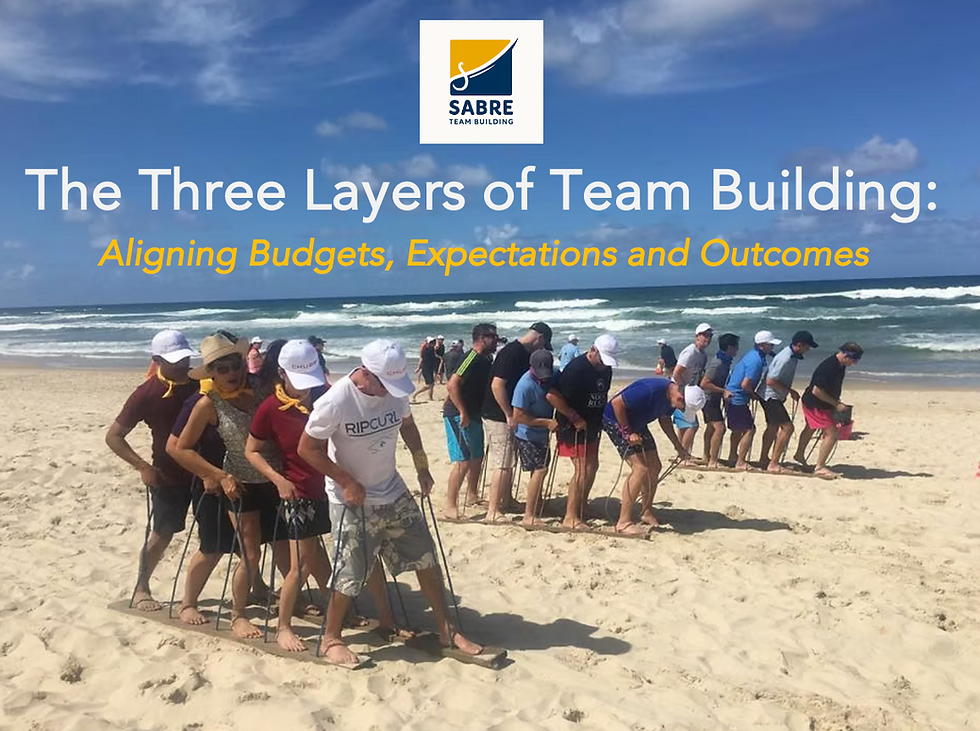The Three Layers of Team Building: Aligning Budgets, Expectations and Outcomes
- The Sabre Team
- Jul 31
- 2 min read
Updated: Jul 31

Team building does come in many different shapes and sizes—from a casual afternoon of games to the deep-dive development workshops.
One of the most common pitfalls in team building is a potentially disastrous mismatch between expectations, budgets, and the actual outcomes that different styles of team building can realistically deliver.
Understanding the three layers of team building sophistication is critical for organisations wanting to maximise ROI from the spend and avoid disappointment or lasting harm to team dynamics and relationships.
Layer 1: Low-Level Team Building – Fun and Engagement
This level typically involves modified leisure activities, reality TV show parodies, or simple team games. They’re great for:
Breaking the ice
Boosting morale
Offering a memorable shared experience
These activities often serve as a reward or a fun break from the routine. But while they can deliver surface-level engagement, they should not be mistaken for deeper team development tools.
Caution: Low-level activities, especially those with physical components, may not be inclusive. They also risk amplifying interpersonal tensions if underlying team issues exist, especially in competitive formats without proper facilitation.
Appropriate expectations are essential—this level is about shared fun, not fixing dysfunctional dynamics or teaching complex collaboration.
Layer 2: Medium-Level Team Building – Challenge and Reflection
At this level, the activities become more sophisticated in design—often in the form of business games, scenario-based challenges, or themed simulations. While still engaging and creative, these sessions are designed to elicit:
Deeper teamwork behaviours
Problem-solving under pressure
Cross-functional collaboration
Medium-level experiences strike a balance between entertainment and structured learning. They offer more meaningful takeaways and can be mapped to real business challenges or learning objectives, making them a strong option for both conferences and internal development sessions.
Facilitation is key here—without it, valuable insights can be lost, and outcomes may not transfer back into the workplace.
Layer 3: High-Level Team Development – Real Change and Growth
This top tier is where genuine team development happens. High-level programmes are often tailored workshops or offsites that incorporate:
Evidence-based tools like the Belbin Team Role Model
High-level facilitation by experienced consultants
Diagnostic insights
Long-term workplace tie-ins and follow-through strategies
These sessions address real-world dynamics, psychological safety, leadership behaviours, and team role diversity. Activities may still be creative and engaging, but they serve a strategic purpose—not just entertainment.
Here’s the trap: trying to achieve high-level outcomes using low-level tools. Expecting transformational change from a half-day game show activity simply doesn’t stack up.
Budget, Skill, and Purpose Must Match
As the sophistication of team building increases, so too must:
The level of design and facilitation skill
The realism of budget expectations
The clarity of objectives
A well-structured team building approach starts by asking:
“What outcomes do we need—fun, functional improvement, or fundamental change?”Then, ensure the budget, activity type, and delivery team are aligned accordingly.
Final Thought
Team building is not a one-size-fits-all solution. When properly matched to your team’s needs, it can be incredibly powerful. But success lies in choosing the right tool for the job—and recognising that deeper transformation demands deeper investment.





Comments